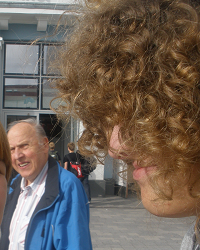eduard
About
- Username
- eduard
- Joined
- Visits
- 1,402
- Last Active
- Roles
- Member, Moderator
Comments
-
Hi @marcl, I guess the parallel port plugin is not available yet for Opensesame 4. @sebastiaan, is there a plan for adding it, or does it depend on somebody else? You might want to look into using Python directly (from within Opensesame) to connect…
-
Can you share your experiment in that case? I don't see any obvious problem with your code. Eduard
-
Hi Effie, Which solution makes the most sense depends on the implementation that you have so far. How about you share your solution to record and save wav files, and we start from there? Generally, I see to options. 1) redirect the audio stream t…
-
Hi @bssengul This looks like Python code. Python does not work in osweb, you need to use javascript. See here for more details: https://osdoc.cogsci.nl/4.0/manual/javascript/about/ Hope this helps, Eduard
-
Hi YOonah, it wouldn't be impossible, but quite a bit of programming necessary. I don't think it'd be worth the effort, so yeah, splitting the experiment sounds reasonable. Good luck! Eduard
-
Hi, Is this a bug report, or a request for help? If you can't rightclick, you may be able to drag and drop the items into the unused items section? Alternatively, you could disable them by setting the run_if field to never instead of always E…
-
Hi Yoonah, I am also wondering if it is feasible to embed a Google Survey link in the experiment That is possible, but a bit impractical, as your participants essentially need to leave the experiment, and can't automatically be directed back. So yo…
-
Hi Leo, This does sound weird! To be sure that the volume within Openessame really increases, you can print out the volume on every iteration of sampler call. I add an experiment for demo purposes. Perhaps you can try that? https://forum.cogsci.nl…
-
Hi Sabrina, messy log files Not much to do about it. You have three options (ordered according to required work and my recommendation): 1) Split the experiment into IAT experimental bits (where you get the long format per default), and the questio…
-
Hi, Of course that depends on the research, but having data collected on computers and phones doesn't sound like a good idea. But anyway, I don't think there is an easy solution to it. You might be able to achieve "zoomability" by not runn…
-
Hi Sabrina, Can you share your experiment. What you describe should be possible. How exactly depends a bit on the data format. Eduard
-
Hi Tomer, Please share complete code or better yet your experiment with a complete error message. With the bits of information you provide it is not really easy to identify the problem. Eduard
-
Hi Leo, I am not sure whether there are ways to let the width of the text adapt to the width of the screen.The sketchpad does that based on the settings you specified in the general properties tab, but indeed when running the browser the autowrap s…
-
Nice, thanks!
-
Which version of Opensesame do you use? With OS4, I can't open your experiment, with OS3, I can open it, but cannot run it. In any case, try replacing the practice_completed sketchpad with a feedback item.
-
Hi Yoann, I can't see an attachment?
-
Hi, You must be missing something, because variables do update. A common mistake is that the value of a variable in a sketchpad reflects its state during the prepare phase and not the run phase, meaning that response-related changes are not incorpo…
-
Yes!
-
Hi Kazald, Ah, I see. At the moment, there is no way to change this as a setting in Opensesame. If it is really important to you, you can go this file in your Opensesame installation lib/python3.7/site-packages/libopensesame/widgets/_form.py and ch…
-
Hi, Yeah, that's a valid point. OS4 was released before everything (plugins, tutorials, etc) that you can find on the web was updated to 4.0, mostly for practical reasons. In the case of webgazer, I don't know whether the support as intentionally d…
-
Hi Kazald, your experiment is empty, I can't check the behavior you are describing. Could you reupload with one of the forms you experience the problem with? Eduard
-
Hi, Could it be that your friend has a different version of Python? It says here, that Pylink only works with Python 3.10. You have Python 3.11 installed. Other than that it is hard to say what causes yourproblems without further information. You c…
-
Hi Marios, This deprecation happened a long time ago: https://osdoc.cogsci.nl/3.0/miscellaneous/important-changes-3/#the-var-object-easy-getting-and-setting-of-experimental-variables It was still possible until recently, but not necessary. To set a…
-
Hi, Not an expert here, but I suppose this is a conflict of versions. That experiment was written for 3.3, and apparently does not work with Opensesame 4.0. Why this is I don't know, but potentially to do with any of the backwards incompatible chan…
-
Hi, It depends on whether you care for absolute response times. If you do, you need as accurate an estimate as possible 216 ms. If you don't, it doenst matter what you use. After all you are essentially just adding a constant to your actual RTs. Th…
-
Hi, The experiment is a bit too complex to easily point you to the solution. If you look at the error message, you see that line 82 of the prep2_1 inlinescript is the culprit. You can try to print out the values for i and neutral1 to understand wha…
-
Hi Silk, Thanks for this report, very appreciated! Perhaps you can post it on github? Bug reports are better placed there: https://github.com/open-cogsci/opensesame-extension-osweb Eduard
-
Hi zgolot, So, it runs with opensesamerun when using windowed mode? Have you also tried different backends? @sebastiaan, is that intentional? Or did opensesamerun break during the update? Eduard
-
Hi, Yeah, sounds legit. Eduard
-
Hi Sarah, yeah that sounds correct. But to be sure, you can check the calibration points, which should also be in the EDF file. When you subtract half of the width/height from them, and plot circles at those locations, can you reproduce the calibrat…


